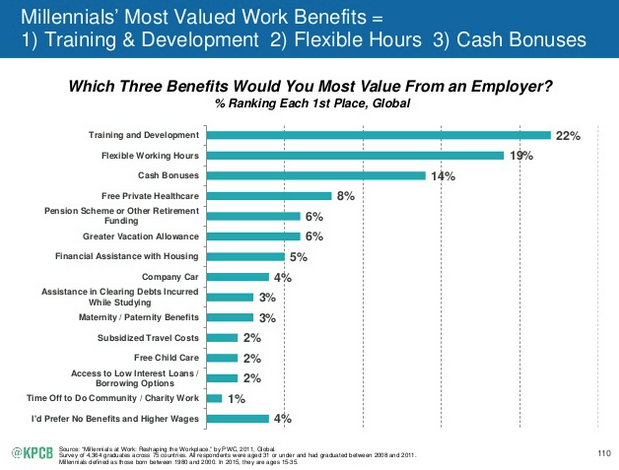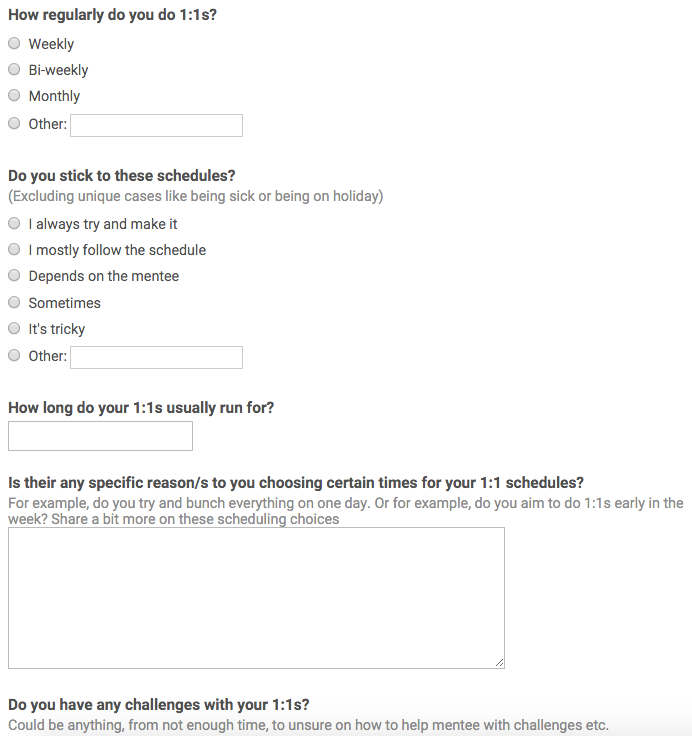
We Don’t Have Performance Reviews at Our Startup: Here’s What We Do Instead
Former Director of People @ Buffer
I remember the feeling—the sleepless night beforehand, the nervousness in the pit of my stomach.
I was waiting for the results of my annual performance review.
Performance reviews—most often yearly—are how many companies provide feedback to their employees. They often involve a numeric rating and maybe an hour or so of conversation about what’s gone right throughout the past year and what could use improvement.
There are a few flaws in the system:
- It’s hard to remember what you did (or didn’t do) in a whole year.
- Getting a “rating” can derail what could have been a thoughtful conversation.
- No matter how much positive feedback you get, it’s easy to key in on the negative.
- It’s generally information you could have used a lot sooner.
Lately, there’s been a bit of a quiet revolution going on in the world of evaluating employee performance. A variety of innovative companies are reformulating the standard review, while others are ditching it altogether.
Our real-time culture—including the rise of social media–could be a big part of the reason. Here’s Accenture chief executive Pierre Nanterme in the Washington Post:
“If you put this new generation in the box of the performance management we’ve used the last 30 years, you lose them. People want to know on an ongoing basis, ‘Am I doing right? Am I moving in the right direction? Do you think I’m progressing?’ Nobody’s going to wait for an annual cycle to get that feedback.”
In fact, a recent study found that the No. 1 thing Millennials want from work is more opportunities to learn and develop:

At Buffer, we’ve found ongoing, weekly feedback to be the best path toward continuous improvement—plus, you get to skip the nervous stomachache!
It took us some time to figure out how to structure our coaching and feedback processes, and they’re likely to change again! But we wanted to share how we do things now in case its helpful for others.
Our core coaching unit: One-on-ones
Early on at Buffer, we began one-on-one sessions between every teammate and their team lead at least every 2 weeks.
We’ve had many different iterations of the structure of these sessions. Generally they last about an hour and include time for achievements, challenges, and feedback from the team lead to the teammate.
Most often, they look like a team lead asking a simple question like “How is it going this week?” and the teammate taking the session anywhere they like.
I’m lucky enough to have my one-on-ones with Leo, who has coached me on everything from role-based stuff like press and public relations to general life stuff like polite persistence and confidence. It’s a special relationship, and one that I know has challenged me to grow immensely.
For the team member, not the team lead
One element of our one-on-ones that might feel a bit different than most types of feedback sessions is that they are almost completely driven by the teammate, with very little time for the team lead to be “in control.”
Ben Horowitz wrote a great article entitled One on One that sums up the impetus behind this:
“The key to a good one-on-one meeting is the understanding that it is the employee’s meeting rather than the manager’s meeting.”
When the majority of the time is dedicated to the team member, and it is up to them to set the agenda, it becomes very empowering.
For instance, I’m aware that I’m going to chat every Wednesday with my lead and that it’s up to me to come up with something to talk about. Because of this, I jot notes throughout the week about things I want to celebrate, things I’d love advice about and issues I think might need a focused discussion.
This tends to surface topics, thoughts and ideas that might have gone unnoticed and forgotten otherwise. It also helps me stay accountable to making progress throughout the week so I always have something new to share!
I always leave one-on-ones feeling energized and supported.
A constant work in progress
Once you get into the groove of doing one-on-ones consistently for a while, there’s a trust and momentum that builds, and it feels like it moves the whole team into a whole new gear.
For teammates, it’s an open-ended way to work through challenges, get advice and brainstorm together. For team leaders, it’s a great way to get signals about what’s working well and what could use some extra thought in terms of workflows and structure.
But we’re always working on ways to make this process even more fulfilling for both parties. Here’s a look at a survey we recently sent out about one-on-ones:

Recently, this great article about better one-on-ones has been going around our virtual office and inspiring us. If we make changes to our system, we’ll be sure to share it with you!
A bonus personal growth machine: Masterminds
In addition to one-on-ones, teammates have another option to pair up, celebrate achievements and work through challenges with peers. We call these sessions “masterminds,” and they go way back to our startup’s beginnings.
In the very early days, Buffer co-founders Joel and Leo would spend their Friday nights at Samovar in San Francisco, drinking tea and having what they call “the most productive hours” of their week in a mastermind chat.
These sessions continue virtually today, no matter where they are in the world.
We’ve had many different iterations of the structure of our mastermind sessions, and they’re still evolving today. Some teammates use this structure today:
- 20 minutes to share and celebrate your achievements (1o minutes each)
- 40 minutes to discuss your current top challenges (20 minutes each)
Both of these sections serve a different purpose, and together they combine to create a very productive session.
I’m lucky enough to mastermind with Buffer’s blogger extraordinaire, Kevan, and I get so much out of our time together. It’s a space to be deeply vulnerable—it’s almost like weekly therapy!
We follow the general format above and have also invented a few of our own rules:
- There’s no such thing as a small achievement! (we kept calling them small until we created this rule)
- No validating one another. (In other words, if I say “I think I could have done better on this,” Kevan can’t say “No, you’re great!” Instead, he will stick with questions as to why I think I need to improve and how I’ll get there.)
Peer-to-peer, personal and professional
Not all teammates choose to participate in masterminds—they’re optional.
During our experiment with self-management, we dropped one-on-ones totally and encouraged everyone to do masterminds instead. Now we’ve realized that mentorship is super valuable and returned to one-on-ones, but some of us continue to find value in masterminds as well.
The peer-to-peer nature means we can share challenges and experiences with others going through a similar journey.
Ideally, they work best with someone whose work is at least somewhat similar to yours, so you can share the most overlap in challenges and achievements.
Anything goes in these sessions—both professional and personal discussions are common.
One of the unique values in the culture at Buffer is to “Have a focus on self-improvement”, and this means talking about personal improvements is encouraged—for example, improving your sleep, learning a new language, trying new forms of exercise, or writing more frequently.
What’s the difference?
The key difference between masterminds & one-on-ones is the relationship: Masterminds are peer-to-peer while one-on-ones are a mentor/mentee relationship.
For some people, one-on-ones fulfill most of their needs for working through challenges. In that case, it feels great to stick with just that.
For new teammates, we encourage them to explore masterminds if they feel drawn to it, but also be very reflective on what they contribute. If the mastermind doesn’t quite feel high value, then they’re encouraged to feel free to rather focus on one-on-ones instead.
The key to both: Listening, not solving
During both of these kinds of sessions, there’s one key rule we try to live by: Listen closely and ask questions, but don’t try to solve others’ problems.
The aim is to help the other person to think about the challenge differently and come up with their own solution.
We may ask questions and perhaps share thoughts or similar experiences, but we try stop short of solving.
It can be really hard to hold back! Buffer is a pretty empathetic team, and we all want to help. But we’ve learned that through asking questions, you often find that your own idea wasn’t quite the right solution.
Plus, it is a hundred times more motivating for the other person to come away knowing that they came up with the solution themselves. Galileo explained perfectly why we try to approach it in this way:
“You cannot teach a man anything; you can only help him to find it within himself.”
Do you have performance reviews at your company, or a different kind of process for feedback?
We’d love to hear your thoughts!
Try Buffer for free
140,000+ small businesses like yours use Buffer to build their brand on social media every month
Get started nowRelated Articles

How the Buffer Customer Advocacy Team set up their book club, plus their key takeaways from their first read: Unreasonable Hospitality by Will Guidara.

In this article, the Buffer Content team shares exactly how and where we use AI in our work.

Here we go again. If you work in social media, it’s nothing new to adapt and change your strategy based on the ever-changing algorithms and the rise and fall of social networks. (Who else was on Vine? 🙋🏻♀️) But, of course, we wish you didn’t have to. The latest wave for social media marketers and creators is that TikTok might be banned in the U.S. The short-form video app has become one of the most widely-used social media platforms and is credited with impacting trends and cultural shifts.